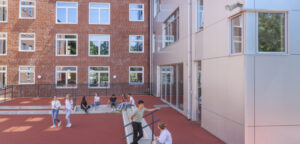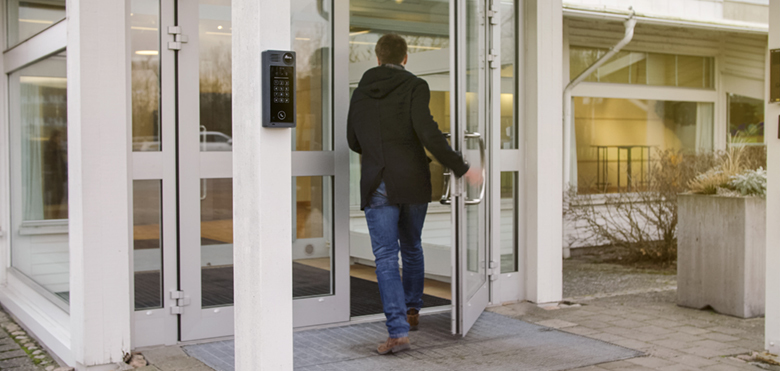Beyond security: how internet of things strengthens higher education
University campuses are busy places. Each day, thousands of students travel to and from classes while open days and sporting events draw in thousands of visitors. With such large-scale operations, the staff required to keep this all running is enormous. Yet, these same students, lecturers, administration staff, and visitors need to feel safe and secure at all times. It’s a big challenge, but there are solutions. Multipurpose Internet of Things (IoT) devices can contribute significantly, providing assistance, alerts, and reassurance to campus life. Their presence deters potential offences and captures those that sadly occur. But the benefits don’t stop there. They can improve efficiencies across departments, enhance the student experience, and improve accessibility standards.
Thanks to how easily IP based systems integrate with existing networks and IoT platforms, campuses can readily unlock a whole raft of benefits. Here’s how:
Ensuring the safety and security of people
Campuses must be both safe and secure, even when city streets and public traffic run right through them. For that to happen, you need great situational awareness. Scene analysis and crowd analytics can help monitor all kinds of situations. For example, instances like overcrowding can be preemptively addressed by issuing redirection instructions or announcements. Additionally, with advanced behavioral analytics, systems can even anticipate when critical situations, such as crashes, may arise, triggering messages or warnings via network audio speakers to diffuse situations. Alternatively, operators can readily step in to deliver live directions and instructions.
Unfortunately, violence toward staff is a prevalent and rising issue. In fact, research conducted by University of Ottawa in 2021 found that 70% of their staff surveyed had been subjected to some form of workplace violence. Bodyworn cameras can be worn as visible deterrents of violent behavior towards staff. Should an incident occur, the camera helps protect personal liability by providing first-hand untampered evidence of what took place. Similarly, body worn cameras can assist campus security, while using the other cameras around campus to locate and respond to incidents.
When incidents that require investigation sadly occur, these same systems can assist. In 2022 Australian Grammar School, Ivanhoe, invested in network cameras to capture the full breadth of its new Sports & Aquatic Centre’s pool environment. Not only did the network cameras enable the school to investigate incidents on-campus in detail, even across large open spaces, but it also meant the school could assist law enforcement in its investigations of incidents that occurred on public streets beyond the perimeter of the school’s grounds.
And lastly, to help students feel safe – particularly at night – emergency duress stations can be set up for 24hr assistance. Should someone feel unsafe, they can push an SoS button to alert for help. Even if they’re unable to speak, the alert will draw attention to them and the camera will identify who needs help.
Improved access control and safeguarding property
The other side to the safety coin is security. IoT solutions are integral to securing facilities while improving access to those who should have it.
At university, students need access to laboratories, computer rooms, and libraries at all hours. Managing who can go where is made relatively simple with the right access control solution. Beyond management, it improves accountability, especially in areas where there is access to sensitive or dangerous materials. From a monetary perspective, network access control can also be a more cost-effective alternative to traditional lock and key, particularly if local legislation mandates re-keying of doors in the event of a lost or stolen key. New key codes or passes can be quickly digitally re-issued rather than the long and expensive prosses of changing the locks.
On big match days between rivals, universities can become like festivals – with food vendors, sponsors, spectators, and the media all flooding to catch the game. With so much taking place all at once, keeping people in the right area is paramount. With remote access controls, entire areas – such as sports arenas – can be locked off or opened up as needed, with access automatically provisioned to staff. Systems can then monitor these large areas and alert of any potential intruders or suspicious behavior. Correct dorm access is also always high on the priority list. Systems can provide automated ID verification to specific students in each dorm, with access refreshed and reissued automatically to keep previous years occupants out.
During these occasions where such large numbers of people are present, deterring vandalism and theft is vital. This is especially the case in areas like car parks. Luckily surveillance systems are proven to deter these types of criminal activity. Research by the UK’s College of Policing found surveillance cameras led to a 37% overall decrease in car park crime compared to those without.
Improve efficiency
Looking beyond safety and security, these same IoT systems can also help drive efficiencies across departments. One camera can support a range of purposes, streamlining processes and informing moment-to-moment decisions that add up to significant savings and coordinated management.
Providing assistance to visitors takes up an inordinate amount of staff hours. Fortunately, many of these administration and security tasks can be automated. The check-in process is one example of this. QR codes via network intercoms can be issued for guests, confirming attendance and also serving as ID validation for access to certain areas. Queue monitoring for buying tickets or food can also be enhanced, alerting staff to when a new counter needs to be opened. All of these help cut operating costs.
When it comes to day-to-day life on campus, speakers can support a more effective flow of students. If there’s overcrowding or an emergency, they can send a public announcement such as, “avoid the north wing due to heavy congestion”. Network audio can also integrate with the existing bell systems. You can set zoning, grouping, and timing for a truly customizable announcement system.
And even routine maintenance tasks can be streamlined. Devices can report their health, like lightbulbs that need changing, obscured camera lenses, audio speaker health, and foliage that needs removing. These simple reporting capabilities can save countless man-hours of walking round campus inspecting each element.
Enhancing the student learning experience
An integral part of the student experience is defined by how well universities meet a diverse range of needs. Inclusivity through accessibility is vital. Where students are unable to physically attend their studies, devices can provide remote access to lectures, lab demonstrations, and speaking events, enabling remote learning and recorded lectures to be reviewed.
Students need to hear their lecturers clearly. No one enjoys an echoey lecture hall, especially those with hearing impairments. Lecturers can use announcement speakers to improve audio quality while recording directly from their microphones, removing any muffled or chatty background noises. And when navigating the campus, intercom door stations can provide assistance to the hearing impaired by transmitting audio from the intercom directly to a person’s hearing aid. This is especially useful when two-way video is unavailable to assist with lip reading.
Students also want their university to align with and reflect their values. Universities need to procure and work with sustainable partners in everything they do. Working with vendors that hold high ethical standards and are transparent is key. Consider the energy impact of your system, how the suppliers source materials and supply chains, as well as how they construct products with the environment in mind.
Embracing a multipurpose solution
Cameras are no longer just tools that show us what is happening, or what has already happened. Network solutions contribute to a culture and a way of operating that upscales the entire quality of the campus experience.
From security and safety through to departmental operations and accessibility, multipurpose, interconnected devices alongside sophisticated analytics can cost-effectively enhance every aspect of university operations.
Explore more ways that Axis can enhance your higher education campus




